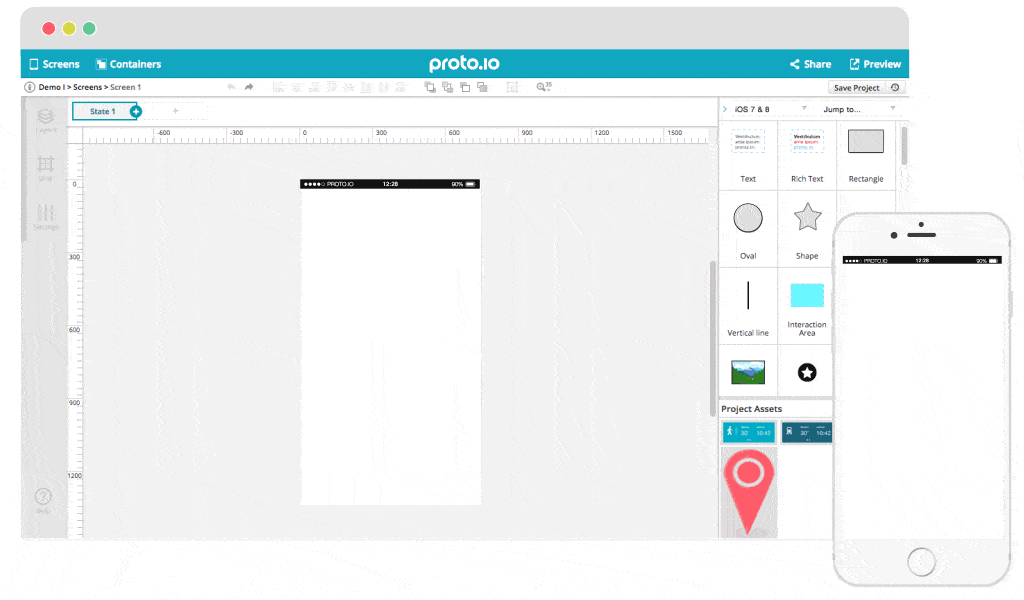When I was reviewing tons of apps and design concepts for June’s edition of Top 10 Mobile App UI, I came across a beautifully-designed emotion-based chat app with unique fluid interactive elements, such as chat bubbles that literally float up to join in the conversation upon hitting ‘send’.
Although my eye was on the design, I was curious as to how this could be developed if it was even possible. So I sent it along to some mobile developers I know, along with the question, “On purely development terms, can you make this happen?”
The unanimous response that came back was, “What the hell!”
Unfortunately, that’s also a very common response you get from designers when they review a final product developed not quite to the specific design they had in mind. Having worked in a digital agency briefly as a Project Manager, I’ve had enough experience being the bearer of “What the hell” messages between two individuals sitting across the room from each other.
Why don’t designers and developers just get along? Aren’t their final objectives essentially one and the same — to create great products? Do they not belong to the same team?
No doubt, there are many designers and developers out there who get along just fine but yet, the age-old stereotype of the two D’s constantly engaged in discordance prevails. Let’s think about why this is so and how we could go about cultivating friendship between designers and developers. Or least to minimize the daily quota of “What the hell”.
Some have cited the lack of mutual respect as a reason behind the constant tension between the two D’s. I believe that it’s more of a mixture of awe and necessity that provokes this tension.
Designers and developers need each other’s skills to actually build a great product. After all, good design goes nowhere without working functions, and functions without form make a worthless product that not even your mom would use. Knowing that the other is so important and not being able to reproduce his/her work can be frustrating if the big picture is missing.
When I think about design and development, I am reminded of Traditional Chinese Medicine (TCM). As an advocate of the tradition, my mom would always say that TCM works because it tackles health problems by perceiving them within the context of the body as a whole, with every part intricately interconnected to each other.
That is a lot like the entire process of creating digital products. Design and development are intrinsic and crucial parts to the whole process of creating products that help users to solve problems in their lives. Isolating one part from the other would only result in unintended side effects that would require yet more time and effort to resolve. The big picture is really all about maintaining harmony and understanding the context.
Don’t Be An X-File
If we haven’t already, it’s perhaps time to re-think the workflow and to end the isolation. Whether you’re a designer or a developer, don’t hog the process. Doing your part in the project isn’t just about taking the brief, disappearing like an X-file for the next weeks and resurfacing with the ‘perfect’ design or product.
Your work is not a secret and it shouldn’t ever be. Whether you’re sitting next to each other or communicating via Slack/Skype, there is a need to avoid the failure to communicate.
Besides, there’s a lot to talk about. Discuss an asset management strategy, a file-naming protocol, the possibilities and impediments of frameworks, or just plain brainstorming. You’d be surprised how the people you work with can have a very positive impact on your creativity.
Don’t Think That It’s A Waste Of Time
To be fair, I’ve spent half my life protesting against taking bitter TCM herbs for two weeks by saying that taking a shot or a pill gets rid of an illness in three days. Max. Hey, I was a busy kid, who has time to rest, meditate and drink herbal soups for two weeks thanks to a cold.
Likewise, designers and developers aren’t always given the luxury of unlimited time. There are always clients to answer to as well as the endless need to rack up those billable hours. It might seem a lot more efficient to just let the designers design and the developers develop, come what may. After all, it’s not like they’d ever understand each other’s work, would they?
However, the importance of context and harmony cannot simply be ignored. It’s not a waste of time if it would, over time, improve the overall turnaround time for projects and contribute to harmonious co-working.
Don’t Underestimate The Other
Having a different perspective on the same subject doesn’t equate to incapacity to understand. That being said, don’t underestimate the other’s ability to provide insight to your work or their willingness to learn about your field. Introduce them, involve them, and give them space when necessary.
Designers, especially UX designers, should try to involve developers in the design process and seek their feedback. Developers aren’t born with bad taste and as a matter of fact, experienced developers would have applicable ideas and knowledge on what good design is. Be aware of the possible design or content changes and check in with your developers as soon as you can. Understand that a slight change such as removing one paragraph could possibly result in more work than a developer would desire.
On the other hand, developers should understand that although designers aren’t always the best at following the rules, letting them know outright of the standards that would make your life easier helps. Inform the designers of the limitations of platforms and frameworks. Don’t let them sweat through nights producing a beautiful design only to say, “What the hell, it’s not possible.” Get yourself involved from day one.
Whatever the case, don’t be a jerk. A little patience goes a long way to reducing the number of “What the hell”s uttered per day.
Don’t Underestimate Yourself
In middle school, my brother would do my Math homework and I would write his Literature essays. We both strongly believed that I simply suck at Math and that he’s a far cry from being the next Shakespeare. It just seemed a lot easier back then to let each do what he/she does best. Later on in life, I aced an Advanced Statistics class in college, which actually convinced me that I’m not that bad in Math, I just needed practice. Needless to say, I now wish that my brother and I’d never gotten away with it.
Whether you’re a designer or developer, it doesn’t matter if you think that you can’t draw for what’s worth or that coding gives you a brain splitting migraine. No matter what, learning even just the fundamentals of a field that’s closely related to your line of work adds value to your profile. It would also go a long way in helping you understand the work of your designer/developer and to better communicate with them.
That’s not to say that you should become a Jack or Jill of All Trades but with the rising number of designers learning to code and developers keeping up with design trends, it’s safe to say that although we might never see a full convergence, designers and developers are a lot more open to exploring. If you haven’t, it’s time to look into it.
Use Tools To Your Collaborative Advantage
So you stopped taking your design or development process to the dungeons for weeks. You attend each other’s meetings. You started learning about color schemes and read Don Norman’s book or you went to Code Academy and you speak some CSS and JS these days. Now you’re asking, “Is there some awesome tool that makes this whole process of working together even easier?”
Yes! If you’re in the mobile business, we have a great tool that helps to improve designer-developer relations and no, it’s not called Tindev and you don’t swipe left or right.
Proto.io is a mobile prototyping tool that streamlines the process of building a great product. By enabling you to create a high-fidelity fully-interactive prototype that allows you to demonstrate a realistic approximation of the end product, a good deal of misunderstanding and extra work could be cut out from the entire process.
Designers with no coding knowledge can quickly create prototypes that developers can easily understand and review. It’s collaborative, features an awesome asset flow, and with the Proto.io app, you can even download your prototypes to your devices and show them to your team anytime, anywhere. Try Proto.io today.












